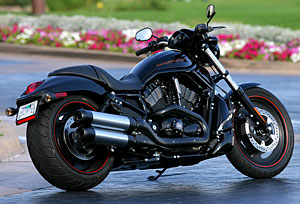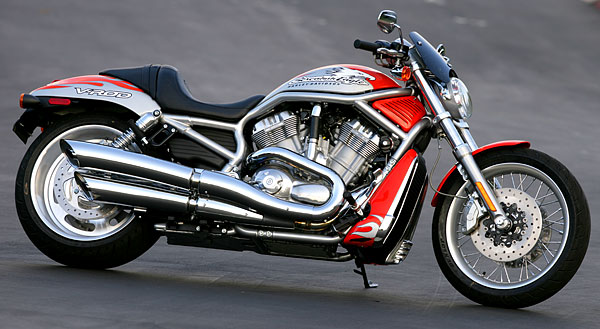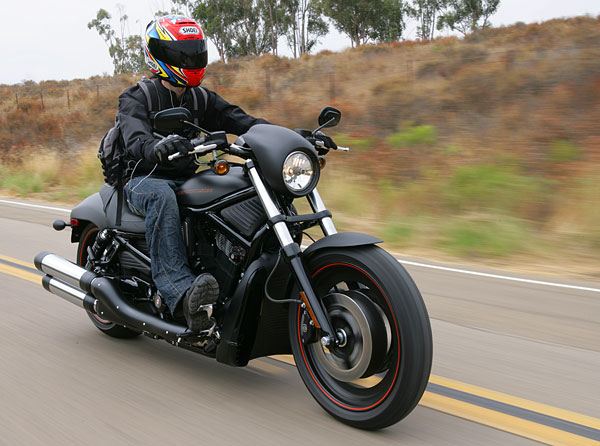
When Harley-Davidson released the original V-Rod in 2002, it was a radical departure from tradition for America’s largest motorcycle manufacturer. Free from the constraints of the traditional architecture of an air-cooled, pushrod V-Twin, the designers in Milwaukee went wild with the appropriately-named ‘Revolution’ water-cooled, overhead-cam V-Rod powerplant – creating the heart of Harley’s entry into the ‘performance cruiser’ segment. The big-bore, short-stroke 1130cc V-Twin is topped with four-valve per cylinder heads, and squeezes the air/fuel mixture to the tune of 11.3:1 compression ratio – a set of terms that would have previously seemed entirely foreign (literally) to die-hard H-D fans who refer to the Milwaukee manufacturer simply as ‘The Motor Company’. Yep, The Motor Company finally did a cutting-edge motor, and they did it right.
Since its initial release, a few variations of the V-Rod have appeared, and the latest are the 2007 Night Rod Special and VRSCX.
The Night Rod Special may be a purely cosmetic makeover of the original V-Rod concept, but boy does it look Tuff. Yep, I spelled it that way on purpose – if you don’t understand why, pick up a copy of S.E. Hinton’s timeless novel The Outsiders. Ponyboy and the gang would have drooled over the Night Rod Special; in fact, seeing one might have inspired a city-wide hubcap theft epidemic as every greaser on the block tried to fund his dream of being the Tuffest kid on the block.
What makes the Night Rod Special so Tuff? Well, aside from the ‘clamshell’ riding position and long, low stance common to all V-Rod models, the Night Rod Special is black. Of course, everyone knows that black is the Tuffest color, and matte black especially so – all the better to blend into that dark alley where you’re hiding from the heat, right? The Night Rod Special is available in two colors – black, and black. What I mean is, you can get one in gloss black with twin matte black ‘racing stripes’, or matte black with gloss black stripes. Both colorschemes feature the same blacked-out treatment on both the steel perimiter frame and the visible surfaces of the Revolution V-Twin engine.
Additional Tuff factor comes from the dual exhaust system, which to my eyes is much more attractive than the oversize single mufflers found on other V-Rod models. Finally, the Night Rod Special has been lowered slightly (about .8″, but it looks like more) in the rear, tucking the 240mm rear Dunlop up into the fender for extra Tuffness (which unfortunately comes at the expense of ground clearance, which we’ll discuss later).
What about the VRSCX, you ask? Built in homage to the V-Rod’s success in the realm of professional drag racing, the VRSCX’s racebike-style silver and orange paint scheme, which features a prominent Screamin’ Eagle logo on the gas tank, is just the opposite of the Night Rod Special’s menacing black treatment. Other than the paint and graphics, there’s little in the VRSCX’s appearance to differentiate it from a standard V-Rod, except the small flyscreen topping the silver headlight housing.

However, appearances can be deceiving, and that’s certainly the case here. The VRSCX isn’t merely a standard V-Rod with cool race-style graphics. Inside the stock-looking cylinders of the VRSCX hide bigger-bore pistons, which team with ported cylinder heads, reprofiled camshafts, and other traditional hot-rodding tricks to boost peak torque output of the now 1250cc motor (the standard V-Rod motor displaces 1130cc) from 74ft-lbs to 86ft-lbs. H-D doesn’t publish claimed peak HP figures, but from riding the VRSCX, we’re certain it makes significantly more horsepower than the original V-Rod. Not a bad thing, considering that even the standard 1130cc V-Rod powerplant is an extremely strong motor.
The first V-Rod variant I swung my leg over at Harley’s 2007 model intro in San Diego, California was the Night Rod Special. After spending a few hours in the Night Rod’s saddle, I found the ‘clamshell’ riding position to be fully as uncomfortable as it looks. The long reach to the forward-mounted footpegs, combined with an equally long reach to the handlebars, forces the rider’s body into a C-shape (thus the clamshell moniker), which while uncomfortable, certainly looks cool, and is typical of many aftermarket customs. The V-Rod certainly has the most extreme riding position of any H-D factory model, but as long as you keep the speeds below 70mph, it’s not TOO bad. Anything faster than that, and your arms and back will be aching in no time.
The Night Rod Special’s 1130cc powerplant packs a surprisingly strong low-end punch considering the 9000rpm redline – around town and in the canyons, gear selection is mostly an afterthought, and passing is as simple as rolling into the throttle. Rev out the Revolution V-Twin, however, and you’re in for a real treat – the power just keeps coming, climbing in a linear fashion until it starts to flatten out slightly around 8000rpm. The Revolution motor is certainly the Night Rod Special’s strong point – it’s certainly the fastest cruiser I’ve ever ridden by a significant margin, and the increased power really helps considering the size and weight of the Night Rod, which although slightly lighter than many cruisers, still weighs in at a hefty 670lbs ready-to-run (claimed).
With its raked-out front end and extremely long wheelbase, you wouldn’t expect the V-Rod to be much of a corner carver, and you’d be right. A fair amount of effort is required to initiate turn-in, but once the bike is set into the corner, it provides stability and confidence aplenty, right up to its limit. That limit is clearly telegraphed to the rider when the peg starts dragging, which happens slightly earlier on the Night Rod Special than other V-Rod models, due to its lower ride height. The difference isn’t much, however, and if I was looking at buying a V-Rod, I wouldn’t let the lower ride height of the Night Rod Special put me off.
Once the peg touches, it’s possible to achieve a few degrees more lean angle by lifting some of your weight off the inside peg, allowing it to fold up slightly under the pressure of contact with the road. However, this technique (developed by the author while riding in the canyons near Julian, in northeast San Diego county), came with an unintended consequence – the next piece to touch down is not the exhaust system (as might be expected), but the attractive front lower cowl that conceal’s the water-cooled Revolution’s small radiator. After a few hours of canyon carving, both the V-Rods I rode (the Night Rod Special and the VRSCX) were marred by severe scraping to the lower corners of this cowl – so bad it had worn through the paint and started to dig into the plastic. So I have to caution against using the peg-folding technique to hustle your V-Rod through the canyons quicker. However, my obligation to you readers compelled me to find the handling limits of the Night Rod, and find it I did.
The previous paragraph may leave you thinking that the V-Rod isn’t capable of much in the twisties, but in reality, I think I just rode the bike much harder than most potential H-D buyers ever will. Lean the thing over, stop just before the peg touches down, and hold it there – you’ll be taking the corner at a perfectly respectable ‘cruising’ speed, plenty fast enough to have fun with. For its intended use, the Night Rod Special has plenty of handling capability.
All this talk about riding position and handling applies equally to the VRSCX, which has an identical chassis to the Night Rod Special, with one exception – the VRSCX rides at the same height as every other V-Rod model, .8 inches higher in the rear than the Night Rod. As I mentioned earlier, the taller ride height gives a small, but mostly unnoticeable advantage in ground clearance. The only really noticeable drawback of the lowered Night Rod Special is a slightly increased tendency to bottom the rear shocks on large, sharp-edged potholes or bumps – a tendency which I didn’t find on the VRSCX.

So if the VRSCX handles basically the same as the Night Rod Special, and its ergonomics are identical, then the only real difference is the motor, right? Oh, but what a difference it is.
If the standard 1130cc Revolution V-Twin is as strong as most bodybuilders (it is), then the VRSCX’s hopped-up 1250cc version would be found pulling trains and lifting busses in the ‘World’s Strongest Man’ competition. OK, maybe that’s a weird analogy, but it seems appropriate for what can only be described as a ‘musclebike’. The VRSCX seemed to lose out slightly in low-end power (although I didn’t happen to bring a dyno along to verify), but above 4500rpm, it simply eats the standard powerplant alive. Power builds much more aggressively than the standard motor, but the well-tuned fuel injection keeps it easy to modulate. Traction is just as easy to modulate, and with an aggressive throttle hand, the VRSCX can easily light up the rear Dunlop while on the move.
Keep the tire stuck to the pavement, though (which is easy enough, if you have a basic level of fine motor control in your right hand), and the VRSCX moves out with a lust for acceleration that is found nowhere else in the cruiser world, except perhaps in the big-dollar world of huge-displacement ‘crate motors’ ordered from aftermarket catalogs. No doubt about it, this motor is a beast, and anyone thinking you’re riding a standard V-Rod with cool graphics will learn otherwise as soon as the two of you leave a stoplight together.
A quick note about the aforementioned well-tuned fuel injection. As I mentioned a few weeks ago in my review of the 2007 Buell XBs, my experience riding big-displacement Japanese and European performance V-Twins (the kind with overhead cams and four-valve heads, plus high compression) has led me to expect a slightly choppy off-on throttle transition, and somewhat excessive engine braking. Neither of these traits were anywhere to be found on either of the V-Rod variants I tested – Harley’s engineers are doing an excellent job mapping their fuel injection systems for accurate, seamless throttle response.
Of all the factory cruisers I’ve ridden over the last few years, I definitely think the V-Rod has the highest ‘cool factor’ (particularly the Night Rod Special). This is definitely a big part of the draw for some cruiser buyers, but the Night Rod Special and the VRSCX back up their looks with powerful, rideable engines and reasonably good handling for the class. With a US MSRP of $16,495 for the Night Rod Special, and $19,995 for the VRSCX, these V-Rod variants are comparable in cost to Harley’s popular Softail, while providing much more performance and, at least in my opinion, far Tuffer looks. That’s a combination that I’m certain many buyers will go for. Now they just need to build my dream V-Rod – a matte-black Night Rod Special with the engine internals of the VRSCX, and throw that Screamin’ Eagle logo on the tank in H-D racing orange. I’d open my wallet for that one, for sure – just as soon as I finished stealing every hubcap in the neighborhood.






